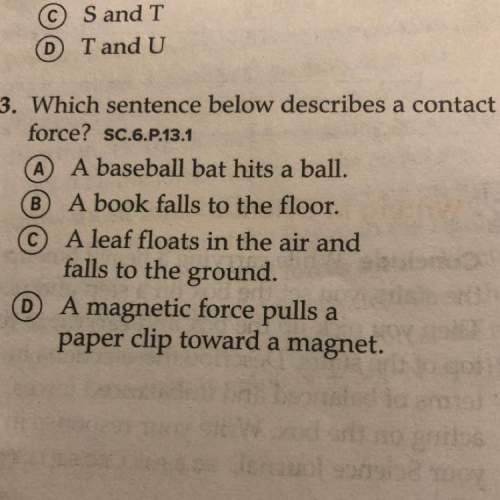
Physics, 14.01.2020 07:31 lizdeleon248
Ineed to know the answer and explanation if possible !


Answers: 2


Other questions on the subject: Physics

Physics, 21.06.2019 17:10, Bamaboy8804
Space-time metric ds2= -dt2+at2dx2+bt2dy2+ct2dz2 (a)how does the area of a rectangle with vertices at ( x=0, y=0, z=0 ), (1,0,0 ), ( 0,1,0 ) and (1,1,0 ) changes with time? (b) if a photon moving in the x direction starts from the origin at t=1, when does it reach x=l? (ds=0 for the trajectory of a photon.) (c) the proper time for a particle is defined by cd=ds. what is the proper time for a particle to move along the trajectory ( x(t)=t, y(t)=0, z(t)=0 ) from t=0 to 1 ? what is the condition on the parameter a so that the velocity of the particle never exceeds the speed of light ?
Answers: 2

Physics, 22.06.2019 00:00, faithcalhoun
How do the measurements of charge at the different locations on the sphere compare to each other? the charge measurements are different at all locations on the sphere. the charge measurements are virtually not the same at all locations on the sphere except for the charge at the very top and at the very bottom that are equal. the charge measurements are virtually the same at all locations on the sphere except for the charge at the very top. at the top, the conductive sphere has a small disk that is made of different material. the charge measurements are the same at all locations on the sphere. what happens to the charge on the conductive sphere when it is connected to a source of charge such as the electrostatic voltage source? nothing will happen because no charge goes around the surface of the sphere. the charge on the conductive sphere spreads out over the surface of the sphere; being greater in some specific locations on the sphere. the charge on the conductive sphere spreads out uniformly over the surface of the sphere. the charge on the conductive sphere spreads out non-uniformly over the surface of the sphere.
Answers: 3

Physics, 22.06.2019 06:00, nelsy7610
Suppose water is leaking from a tank through a circular hole of area ah at its bottom. when water leaks through a hole, friction and contraction of the stream near the hole reduce the volume of water leaving the tank per second to cah 2gh , where c (0 < c < 1) is an empirical constant. a tank in the form of a right-circular cone standing on end, vertex down, is leaking water through a circular hole in its bottom. (assume the removed apex of the cone is of negligible height and volume.) (a) suppose the tank is 20 feet high and has radius 8 feet and the circular hole has radius 2 inches. the differential equation governing the height h in feet of water leaking from a tank after t seconds is dh dt = − 5 6h3/2 . if the height of the water is initially 8 feet, how long will it take the tank to empty? (round your answer to two decimal places.)
Answers: 2

Physics, 22.06.2019 11:30, azduce
(2) (a) you have a simple circuit that consists of only a battery (δvbat=1.5v) and two resistors with resistance r1=10ω and r2=5ω, connected in series with each other. what is the current running through the battery? (b) you re-arrange your circuit so now r2 is attached in parallel to r1 rather than in series. what is the current running through the battery? (c) you add an additional resistor r3=7ω on the same branch as r2. what is the current running through the battery? (d) what is the power dissipated in r3?
Answers: 3
You know the right answer?
Ineed to know the answer and explanation if possible !
...
...
Questions in other subjects:


Mathematics, 26.05.2021 20:00


Mathematics, 26.05.2021 20:00


Biology, 26.05.2021 20:00

Mathematics, 26.05.2021 20:00


Mathematics, 26.05.2021 20:00



